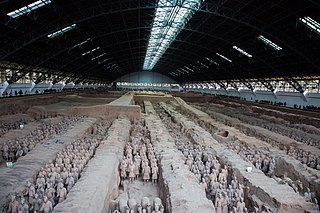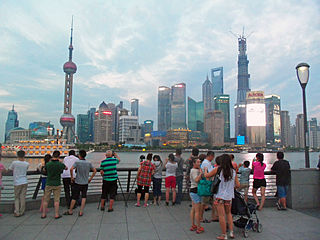
The Terracotta Army is a collection of terracotta sculptures depicting the armies of Qin Shi Huang, the first Emperor of China. It is a form of funerary art buried with the emperor in 210–209 BCE with the purpose of protecting the emperor in his afterlife.

Chongqing, formerly romanized as Chungking, is a major city in southwest China. Administratively, it is one of China's four municipalities under the direct administration of central government, and the only such municipality in China located far away from the coast.
Melbourne Museum is a natural and cultural history museum located in the Carlton Gardens in Melbourne, Australia.

Chenghai is a district of the city of Shantou, Guangdong Province, China.

Nelumbo nucifera, also known as Indian lotus, sacred lotus, bean of India, Egyptian bean or simply lotus, is one of two extant species of aquatic plant in the family Nelumbonaceae. It is often colloquially called a water lily. Under favorable circumstances the seeds of this aquatic perennial may remain viable for many years, with the oldest recorded lotus germination being from that of seeds 1,300 years old recovered from a dry lakebed in northeastern China.

A landrace is a domesticated, locally adapted, traditional variety of a species of animal or plant that has developed over time, through adaptation to its natural and cultural environment of agriculture and pastoralism, and due to isolation from other populations of the species. Landraces are generally distinguished from cultivars, and from breeds in the standardized sense, although the term landrace breed is sometimes used as distinguished from the term standardized breed when referring to cattle.

The National Museum of China flanks the eastern side of Tiananmen Square in Beijing, China. The museum's mission is to educate about the arts and history of China. It is directed by the Ministry of Culture of the People's Republic of China.

Baiheliang is a rock outcrop in Fuling District, Chongqing, People's Republic of China, that parallels the flow of the Yangtze River.

Tourism in China is a significant industry. The rate of tourism has greatly expanded over the last few decades since the beginning of reform and opening. The emergence of a newly rich middle class and an easing of restrictions on movement by the Chinese authorities are both fueling this travel boom. China has become one of the world's most-watched and hottest inbound and outbound tourist markets. According to Xinhuanet, world is on the cusp of a sustained Chinese tourism boom.

Berkshire pigs, also known as Kurobuta, are a rare breed of pig originating from the English county of Berkshire that are bred and raised in several parts of the world, including England, Japan, the United States, Australia, and New Zealand. The Japanese designation of the breed, Kurobuta, has become like Kobe beef, a preferred branding of a premium grade of pork, that has increased the breed's popularity in the 21st century and caused this heritage breed's meat products to command a premium price.

Agriculture is a vital industry in China, employing over 300 million farmers. China ranks first in worldwide farm output, primarily producing rice, wheat, potatoes, tomato, sorghum, peanuts, tea, millet, barley, cotton, oilseed and soybeans.

Love Land would have been the first sex theme park in China; the PRC Government suspended its construction in Chongqing in May 2009 and ordered it demolished for being vulgar and explicit. The park was to include displays of giant genitalia and naked bodies, and host an exhibition on the history of human sexuality along with sex technique workshops. The closure is a reflection of the conservatism with regard to sex in China.

The Baiheliang Underwater Museum or "White Crane Ridge Underwater Museum" is an underwater museum built around the White Crane Ridge of Fuling District (涪陵白鹤梁), Chongqing. It is China's first underwater museum.

Foreigners' Street or Yangren Jie is an amusement park and entertainment area in Chongqing, China. It combines various styles of architecture, food, and attractions from around the world. It is northwest of Jiefangbei on the other side of the Yangtze River.

Fu Wenjun graduated from Sichuan Fine Arts Institute. He is a contemporary artist who works on photography, digital art, installation art, sculpture and oil painting. Currently he lives and works at Chongqing. He has developed his concept and practices of “Digital Pictorial Photography” art style.
Baodingshan is a Buddhist site in Chongqing. The site is located on a limestone outcropping at an elevation of 500 meters, fifteen kilometers north of the city of Dazu, a market town that dates to 758 CE and the city is ringed by religious sites dating from 892 to 1249 CE. Primary construction at Baodingshan took place during the Southern Song Dynasty but it remained largely unknown to the outside world until its reopening to the public in the 1980s, the earliest documented research on the site dating to 1944. The site has since been designated a World Heritage Site since 1999, falling within the collective grouping of Dazu Rock Carvings, a reference to the district in which Baodingshan is located. Dazu County covers 1400 square kilometers northwest of Chongqing on the road to Chengdu. During the Song Dynasty, this area of the Chengdu plain was considered one of the wealthiest regions in China.
Twelve Views of Bayu are popular scenic views in and around the city of Chongqing, China. Ba and Yu are old names of Chongqing in imperial time. Influenced by Eight Views of Xiaoxiang in Hunan Province, people in Chongqing listed their own most beloved views during the reign of Tianshun Emperor of Ming Dynasty. Scenic views in the list changed throughout the history. Some scenic views appeared in earlier lists no longer exist in modern days due to the change of physical geography, landscapes and land-uses.




















